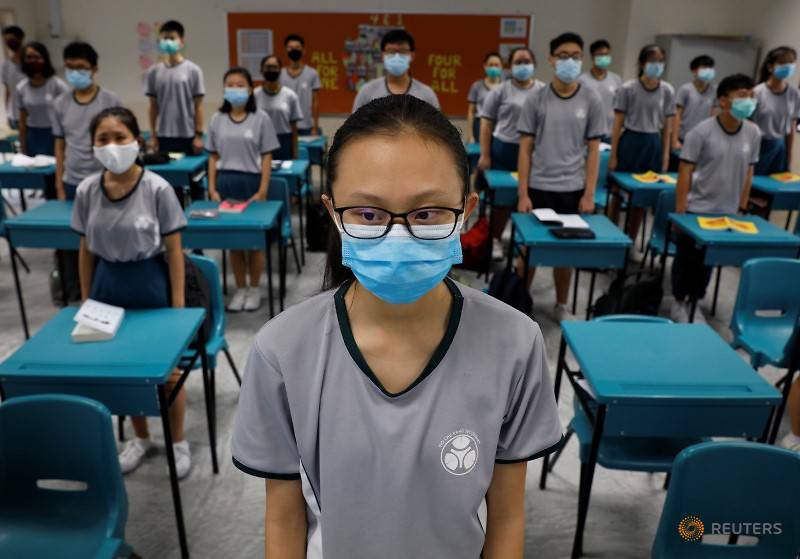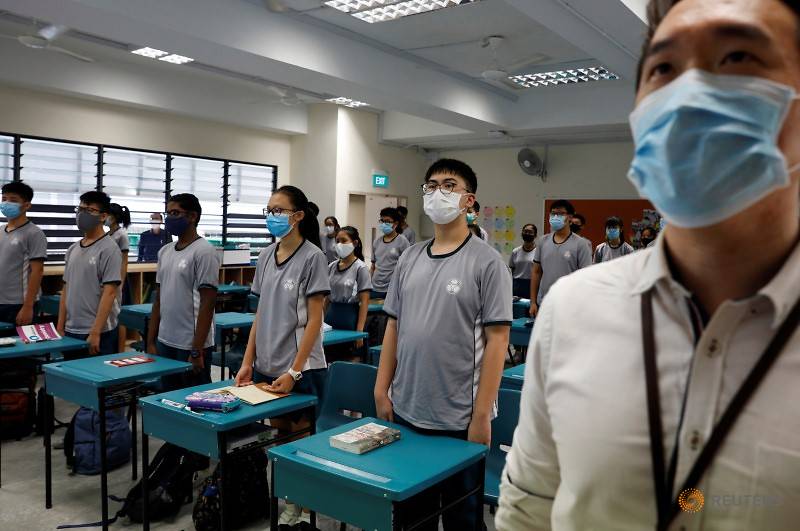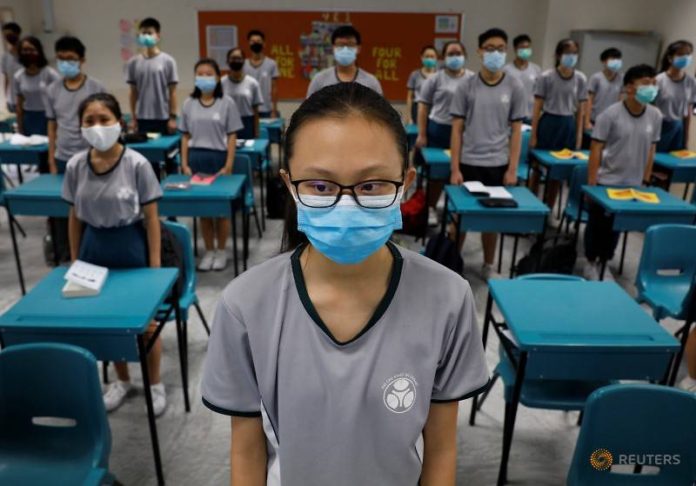SINGAPORE: The COVID-19 crisis has swept through the entire world for most of 2020, creating an unparalleled wave of uncertainty and gloom.
Educational institutions, from pre-schools through to universities, have experienced sudden and unprecedented disruption.
A United Nations Educational, Scientific and Cultural Organisation press release in late March estimated that 1.5 billion students in 165 countries, or 87 per cent of the world’s student population, have been affected by nationwide and localised school closures.
In Singapore, schools and institutes of higher learning were not free from this disruption. They had to shift to home-based learning from Apr 8 to Jun 1.
LISTEN: Home-based learning: Good, bad, terrible … but mostly good?
READ: Commentary: Tired of staring at screens? Here’s how to avoid tech overload while stuck at home
EDUCATORS GET NEW ROLES
Indeed, educators have had to play new roles, like nurse, IT support and social worker, all at once.
Suddenly becoming health promoters overnight, educators had to first educate students about safety measures such as social distancing, wipe-down routines and personal hygiene and take actions to keep concerns from worried parents at bay.
They also had to pay greater attention to students’ emotional health.
Second, many educators were taken by surprise by the abrupt closure of educational institutions. They had to assume the role of information and communications technology (ICT) champions and managers.
Most have experienced a steep learning curve, grappling with the task of editing videos and conducting lessons through digital platforms without the familiarity of face-to-face contact with their students.

Students wearing face masks stand for the national anthem in class at Yio Chu Kang Secondary School, as schools reopen amid the coronavirus disease (COVID-19) outbreak in Singapore June 2, 2020. (Photo: REUTERS/Edgar Su)
They also had to familiarise their students with these new ways of learning.
Despite initial challenges, the good news is many have emerged adept at this task. Educators have risen to the challenge of returning to their roots to find fresh ways to spark creativity, interest and learning.
USA Today featured the story of Brandon Gilliam, who created science experiment videos that his students could reproduce with commonly found household items in May.
Likewise, Janice Wan, a Geylang Methodist Primary School teacher, taught her students the concept of energy by asking them to study the motion of marbles on home-made roller coasters.
A group of Tanjong Katong Secondary School geography teachers also made YouTube videos and used Google Earth to illustrate the concept of coastal protection.
LISTEN: The conversation on race and multiculturalism younger Singaporeans want
READ: Commentary: The case for universal digital access, as home-based computing becomes a post-pandemic norm
Third, school teachers had to be social workers as they attempt to ensure inclusivity and equity.
Some students struggled with inadequate home support during home-based learning or lacked access to Wi-Fi and mobile devices needed for online learning.
Teachers had to proactively reach out to these students and their parents in order to ensure a level learning field.
For instance, CNA reported how Innova Primary School teachers made telephone calls to students who had not turned up for online lessons. They also offered parents assistance with accessing online learning platforms and with explaining concepts to their children.
In some cases, students who needed additional academic help were allowed to return to school during the circuit breaker period.
LEARNING AS EDUCATORS
The almost overnight closures of educational institutions left many educators panicking over how to effectively conduct lessons and to ensure continuity in their instructional programmes.
Innova Primary School student Danial Rizal opening up assignments on the Student Learning Space. (Photo: Ang Hwee Min)
Some educators have stepped up to the role of being formal or informal mentors. I have personally witnessed my department colleagues relate their struggles with conducting lessons on the Zoom video-conferencing platform, while others have offered constructive advice on how to facilitate meaningful student engagement.
In addition, educators have been thrust into the spotlight as model learners for their students.
Not only have educators had to summon their ingenuity and resourcefulness in adapting to the adverse circumstances wrought by the COVID-19 crisis, they have also had to cope with initial setbacks in their attempts to harness ICT while collaborating with fellow educators, gaining greater confidence in their craft in the process.
For instance, a group of teacher educators at the National Institute of Education set up a Facebook group for teachers to share ideas on conducting home-based learning. These educators have had to demonstrate, at short notice, the traits of effective learners.
READ: Commentary: Mothers working from home on Instagram look stylish, serene and nothing like my reality
READ: Commentary: Perhaps now, stay-home mums will get the credit they deserve
MOVING BEYOND ACADEMIC ACHIEVEMENTS
On the bright side, this discussion of educators’ roles has thrown into stark relief the larger purposes of schooling beyond the focus on academics.
The widespread school closures have meant that students lack a physical space in which to interact with their peers. Social distancing measures put in place in the wake of school re-openings have further limited spontaneous interaction among students.
Fortunately, in late July, the Ministry of Education allowed secondary schools and pre-university institutions a limited resumption of co-curricular activities (CCAs), in recognition of the vital role that CCAs play in character development and community building.
A RENEWED FOCUS ON EQUITY AND DIGITAL TECHNOLOGIES
Another major purpose of schooling is to foster equity and social mobility. Once again, educators have had to intensify efforts.
Students wearing protective face masks attend a class at Yio Chu Kang Secondary School, as schools reopen amid COVID-19 outbreak in Singapore. (FILE PHOTO: Reuters/Edgar Su)
Even universities have had to offer greater financial aid to students who have found it more difficult to find part-time employment to pay for their tuition fees and living expenses.
Furthermore, educational institutions have now been forced to re-evaluate and rethink their current teaching and learning practices.
Among the questions being asked is the value of face-to-face student-educator interaction vis-à-vis online learning. Now that students in many cases cannot be in close proximity with their schoolmates and instructors, educators have to open themselves to new possibilities to engage students and leverage new digital technologies.
Such changes were perhaps a long time coming seeing that current cohorts of students have grown up as the first truly digital native generation, with technology an integral part of their everyday lives.
READ: Commentary: How ready are Singapore universities to start the new term as COVID-19 rages on?
READ: Commentary: COVID-19 has shown Singapore digital arts and humanities are quite the essential service
LESSONS LEARNT
The collective experiences of the past few months have underlined the urgency of educators preparing their students to thrive in a world marked by uncertainty and unpredictability.
If and when a greater sense of normality eventually returns, a fundamental shake-up to improve learning and teaching outcomes in all educational institutions is in order.
The crisis has re-awakened calls to overhaul the industrial model of schooling, in which students study at largely the same pace and are taught the same materials by one adult within a classroom.
Besides greater integration of blended learning, or a combination of face-to-face and online instruction, into school curricula, I hope that schools will be better able to harness individual students’ learning speeds, styles or interests when devising learning experiences.
This is perhaps a tall order given the current predominance of examination preparation within both students’ and teachers’ lives.

Students wearing face masks sing the national anthem in class at Yio Chu Kang Secondary School, as schools reopen amid the coronavirus disease (COVID-19) outbreak in Singapore June 2, 2020. REUTERS/Edgar Su
But instead of being passive consumers of knowledge, students can be encouraged to develop into self-directed and autonomous learners.
The disruption to schooling has added impetus to move in this direction by raising questions about how much learning can occur at home and away from face-to-face teacher assistance within a classroom setting.
In addition, the Government and the wider community have to redouble efforts to minimise the sorts of inequalities that have been laid bare. At the same time, the emotional health of students and teachers needs to assume greater priority.
The global nature of this pandemic has also highlighted the need to learn, sometimes across national boundaries, from fellow educators and work collaboratively with them, for example, through leveraging publicly available information disseminated by the Organisation for Economic Cooperation and Development on effective teaching strategies during COVID-19.
LISTEN: Recovery, restructuring and possibly rebound? The outlook for the Singapore economy
BOOKMARK THIS: Our comprehensive coverage of the coronavirus outbreak and its developments
Download our app or subscribe to our Telegram channel for the latest updates on the coronavirus outbreak: https://cna.asia/telegram
Jason Tan is an associate professor at the National Institute of Education.





